Package 'openair'
Package 'openair'
Package 'openair'
You also want an ePaper? Increase the reach of your titles
YUMPU automatically turns print PDFs into web optimized ePapers that Google loves.
84 polarAnnuluskey.footerkey.positionkeyauto.textsee key.header.Location where the scale key is to plotted. Allowed arguments currently include“top”, “right”, “bottom” and “left”.Fine control of the scale key via drawOpenKey. See drawOpenKey for furtherdetails.Either TRUE (default) or FALSE. If TRUE titles and axis labels will automaticallytry and format pollutant names and units properly e.g. by subscripting the ‘2’ inNO2.... Other graphical parameters passed onto lattice:levelplot and cutData. Forexample, polarAnnulus passes the option hemisphere = "southern" on tocutData to provide southern (rather than default northern) hemisphere handlingof type = "season". Similarly, common axis and title labelling options (suchas xlab, ylab, main) are passed to levelplot via quickText to handle routineformatting.DetailsThe polarAnnulus function shares many of the properties of the polarPlot. However, polarAnnulusis focussed on displaying information on how concentrations of a pollutant (values of another variable)vary with wind direction and time. Plotting as an annulus helps to reduce compression ofinformation towards the centre of the plot. The circular plot is easy to interpret because wind directionis most easily understood in polar rather than Cartesian coordinates.The inner part of the annulus represents the earliest time and the outer part of the annulus the latesttime. The time dimension can be shown in many ways including "trend", "hour" (hour or day),"season" (month of the year) and "weekday" (day of the week). Taking hour as an example, the plotwill show how concentrations vary by hour of the day and wind direction. Such plots can be veryuseful for understanding how different source influences affect a location.For type = "trend" the amount of smoothing does not vary linearly with the length of the timeseries i.e. a certain amount of smoothing per unit interval in time. This is a deliberate choicebecause should one be interested in a subset (in time) of data, more detail will be provided for thesubset compared with the full data set. This allows users to investigate specific periods in moredetail. Full flexibility is given through the smoothing parameter k.ValueAs well as generating the plot itself, polarAnnulus also returns an object of class “openair”. Theobject includes three main components: call, the command used to generate the plot; data, thedata frame of summarised information used to make the plot; and plot, the plot itself. If retained,e.g. using output
















